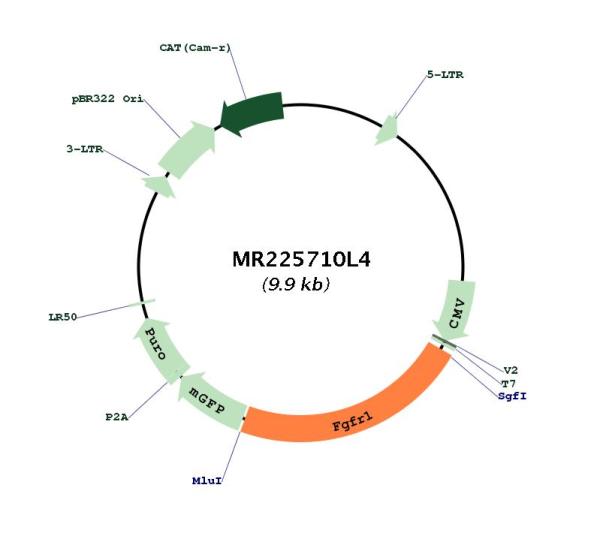Fgfr1 (NM_001079909) Mouse Tagged Lenti ORF Clone
CAT#: MR225710L4
- LentiORF®
Lenti ORF clone of Fgfr1 (mGFP-tagged) - Mouse fibroblast growth factor receptor 1 (Fgfr1), transcript variant 3
"NM_001079909" in other vectors (4)
Interest in protein/lysate? Submit request here!
USD 365.00
Specifications
| Product Data | |
| Type | Mouse Tagged ORF Clone |
| Tag | mGFP |
| Symbol | Fgfr1 |
| Synonyms | AW208770; bFGF-R-1; c-fgr; Eask; Fgfr-1; FGFR-I; FLG; Flt-2; Hspy; MFR |
| Vector | pLenti-C-mGFP-P2A-Puro |
| E. coli Selection | Chloramphenicol (34 ug/mL) |
| Mammalian Cell Selection | Puromycin |
| Sequence Data |
The ORF insert of this clone is exactly the same as(MR225710).
|
| Restriction Sites |
SgfI-MluI
Cloning Scheme for this gene
Plasmid Map

|
| ACCN | NM_001079909 |
| ORF Size | 2193 bp |
| OTI Disclaimer | Due to the inherent nature of this plasmid, standard methods to replicate additional amounts of DNA in E. coli are highly likely to result in mutations and/or rearrangements. Therefore, OriGene does not guarantee the capability to replicate this plasmid DNA. Additional amounts of DNA can be purchased from OriGene with batch-specific, full-sequence verification at a reduced cost. Please contact our customer care team at custsupport@origene.com or by calling 301.340.3188 option 3 for pricing and delivery. The molecular sequence of this clone aligns with the gene accession number as a point of reference only. However, individual transcript sequences of the same gene can differ through naturally occurring variations (e.g. polymorphisms), each with its own valid existence. This clone is substantially in agreement with the reference, but a complete review of all prevailing variants is recommended prior to use. More info |
| OTI Annotation | This clone was engineered to express the complete ORF with an expression tag. Expression varies depending on the nature of the gene. |
| Product Components | The ORF clone is ion-exchange column purified and shipped in a 2D barcoded Matrix tube containing 10ug of transfection-ready, dried plasmid DNA (reconstitute with 100 ul of water). |
| Reconstitution | 1. Centrifuge at 5,000xg for 5min. 2. Carefully open the tube and add 100ul of sterile water to dissolve the DNA. 3. Close the tube and incubate for 10 minutes at room temperature. 4. Briefly vortex the tube and then do a quick spin (less than 5000xg) to concentrate the liquid at the bottom. 5. Store the suspended plasmid at -20°C. The DNA is stable for at least one year from date of shipping when stored at -20°C. |
| Reference Data | |
| RefSeq | NM_001079909.1, NP_001073378.1 |
| RefSeq Size | 4741 bp |
| RefSeq ORF | 2202 bp |
| Locus ID | 14182 |
| UniProt ID | P16092 |
| Cytogenetics | 8 14.12 cM |
| Gene Summary | Tyrosine-protein kinase that acts as cell-surface receptor for fibroblast growth factors and plays an essential role in the regulation of embryonic development, cell proliferation, differentiation and migration. Required for normal mesoderm patterning and correct axial organization during embryonic development, normal skeletogenesis and normal development of the gonadotropin-releasing hormone (GnRH) neuronal system. Phosphorylates PLCG1, FRS2, GAB1 and SHB. Ligand binding leads to the activation of several signaling cascades. Activation of PLCG1 leads to the production of the cellular signaling molecules diacylglycerol and inositol 1,4,5-trisphosphate. Phosphorylation of FRS2 triggers recruitment of GRB2, GAB1, PIK3R1 and SOS1, and mediates activation of RAS, MAPK1/ERK2, MAPK3/ERK1 and the MAP kinase signaling pathway, as well as of the AKT1 signaling pathway. Promotes phosphorylation of SHC1, STAT1 and PTPN11/SHP2. In the nucleus, enhances RPS6KA1 and CREB1 activity and contributes to the regulation of transcription. FGFR1 signaling is down-regulated by IL17RD/SEF, and by FGFR1 ubiquitination, internalization and degradation (By similarity).[UniProtKB/Swiss-Prot Function] |
Documents
| Product Manuals |
| FAQs |
| SDS |
Resources
Other Versions
| SKU | Description | Size | Price |
|---|---|---|---|
| MC221151 | Fgfr1 (untagged) - Mouse fibroblast growth factor receptor 1 (Fgfr1), transcript variant 3, (10ug) |
USD 1,005.00 |
|
| MG225710 | Fgfr1 (tGFP-tagged) - Mouse fibroblast growth factor receptor 1 (Fgfr1) transcript variant 3, (10ug) |
USD 1,271.00 |
|
| MR225710 | Fgfr1 (Myc-DDK-tagged) - Mouse fibroblast growth factor receptor 1 (Fgfr1), transcript variant 3 |
USD 1,071.00 |
|
| MR225710L3 | Lenti ORF clone of Fgfr1 (Myc-DDK-tagged) - Mouse fibroblast growth factor receptor 1 (Fgfr1), transcript variant 3 |
USD 1,371.00 |
{0} Product Review(s)
Be the first one to submit a review






























































































































































































































































 Germany
Germany
 Japan
Japan
 United Kingdom
United Kingdom
 China
China

